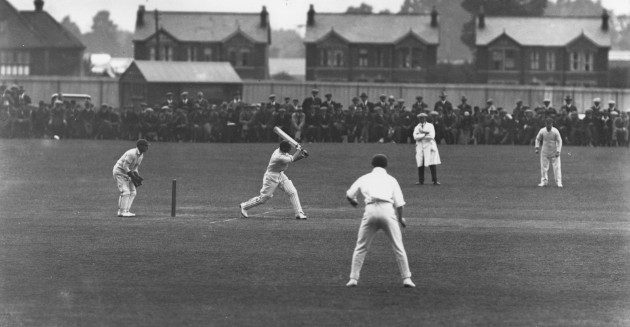The dawn of the new year means we are marking the 100th anniversary of Surrey’s Jack Hobbs making the 100th first-class century of his career. Richard Spiller looks back on the opener’s great moment and other moments of 1923.
Early in the 1923 season, Jack Hobbs was unsure whether he had much future in the first-class game.
Having passed 40, both his health and fitness were troubling him. A torn thigh muscle and then acute appendicitis had cost much of the 1921 season and, although the following summer had brought 2,552 first-class runs at 62, Hobbs found himself tiring more easily and turned down a place on England’s 1922-23 tour of South Africa. He made 10 centuries that summer but a decline in form and the weight of expectation were weighing increasingly heavily and left him on 99 for the winter.
Surrey went into the season among the fancied teams for the County Championship title they had last won in 1914. Since the resumption, they had finished fourth in 1919, third in 1920, runners-up a year later – despite missing Hobbs for so long – and then third again
The first three Championship matches were all on the road, the first at Cardiff seeing Hobbs score a single in the first innings and then, after the Welshmen had been routed for 35 in the second, making 32no on the way to a 10-wicket victory.
That sent the side to Bath for a clash with Somerset, one of two counties against whom he had yet to score a century, but the opening day – Saturday May 5 – was so wet that play was delayed until 5pm and rain returned after three overs with neither Hobbs nor opening partner Andy Sandham having got off the mark
When the game restarted on the Monday morning, Hobbs could only scoop his first delivery to extra cover after it stuck in the soggy pitch. Veteran medium-pacer Ernie Robson also removed Sandham for a duck in claiming 6-59 and Surrey’s 91 all out would have looked even worse but for Andy Ducat making 52no.
They limited Somerset to 140 and Surrey were back in before play ended, losing Sandham (4) again. Hobbs, who admitted later he had felt “sick with the world in general” after his dismissal in the first innings, was nowhere near his most fluent and his nerves were underlined by being involved in the run outs of both Ducat and Tom Shepherd. But with Bill Hitch batting in breezy style at the other end for 67, the pair added 89 for the fifth wicket.
Hobbs found his fluency, a six and four off left-arm spinner Jack White taking him to 94 although he had to rely on team-mates to inform him of his own score given the poor scoreboard at Bath. Three singles took him to 97 and then a push to cover off Robson was augmented by two overthrows and he had finally achieved the cherished landmark, 18 years on from his first, becoming the third man to reach 100 centuries after WG Grace and Tom Hayward.
A legend already for both his achievements and the manner in which he played the game, Hobbs went on to finish on 116 as Surrey skipper Percy Fender declared at 216-5, giving the bowlers sufficient time to dismiss Somerset for 157 in an exciting 10-run victory. Fender’s 4-61 was augmented by Alan Peach claiming 3-39.
Amid the welter of congratulations, Hobbs was gifted 100 guineas by the Surrey committee – who later presented the same sum to his old opening partner and mentor Hayward, who had achieved the feat in 1913 – and far from fading away, it launched the most lucrative run glut of his career. Although Hobbs rated himself a better player before the war, he would score 100 of his 199 centuries after the age of 40, retiring in 1934 with 61,760 first-class runs. It remains a record. The main gates at the pavilion end of the Kia Oval were dedicated to him and he was knighted in 1953.
That 1923 summer was not a vintage one for Hobbs – he finished with 1,595 first-class runs, including four centuries, being outscored by Sandham (1,619) and Ducat (1,626).
Surrey’s bowling, though, and the pitches on which their batsmen flourished at The Oval could not win them sufficient matches to claim the Championship title. Despite the inventiveness of skipper Fender – easily the leading wicket-taker with 136 wickets – they slid to fourth place, taking 15 wins from 26 matches, well adrift of champions Yorkshire.
There was no Oval Test that year, a gap of three years existing between the Australians in 1921 and the South Africans in 1924. Such breaks were not unusual at that time but the only other lengthy break after that was during the Second World War.
What else happened in 1923?
It was a busy year politically. Prime Minister Andrew Bonar Law, who had taken over when the extended wartime coalition led by David Lloyd-George finally ended in 1922, was forced to resign through ill health in May (he died in October). His successor, Stanley Baldwin, led the Conservatives into a general election in December but they could not win a majority and the following year would give way to the first short-lived Labour government.
The vast majority of railway companies were consolidated into regions in an effort to bring greater cohesion to the industry. A century on….
The British Broadcasting Company – forerunner to the corporation – made its first outside broadcast, the British National Opera Company’s production of The Magic Flute at Covent Garden. The Radio Times was published for the first time later in the year and, on New Year’s Eve, the chimes of Big Ben were heard over the airwaves.
Prince Albert, Duke of York – second son of the monarch, King George V – married Elizabeth Bowes-Lyon at Westminster Abbey. They would become King George VI and Queen Elizabeth.
Under the Matrimonial Causes Act, equal divorce rights were established for women and men.
Although hostilities in the First World War had ground to a halt in 1918, echoes continued with troops from France and Belgium occupying the Ruhr in a bid to force Germany into stepping up reparations.
The Great Kanto Earthquake devastated Tokyo and Yokohama, killing more than 100,000 people.
The Empire Stadium at Wembley was opened to the public and staged the FA Cup final between Bolton Wanderers and West Ham United. Mounted police had to clear crowds from the pitch, one officer riding a white horse. Bolton won what became known as the “white horse final”.
Liverpool won the Football League by six points from Sunderland. At Wimbledon, Bill Johnston beat fellow American Frank Hunter 6-0 6-3 6-1 in the men’s singles while Suzanne Lenglen defeated Briton Kitty McKane 6-2 6-2 in the women’s event.









